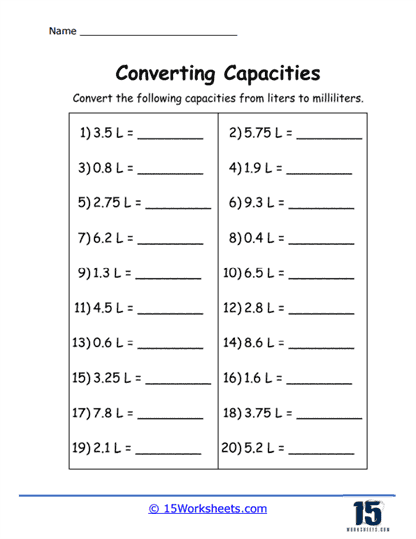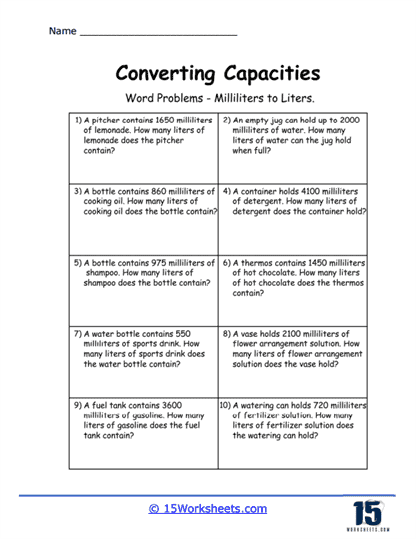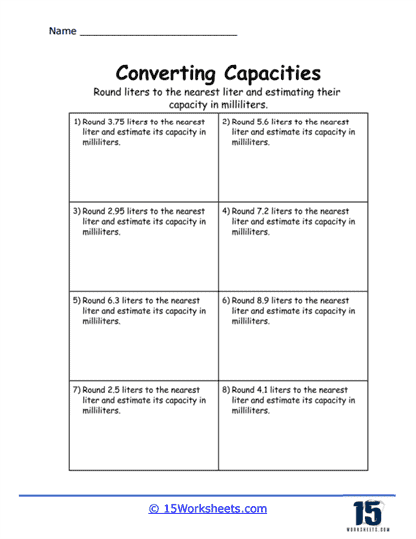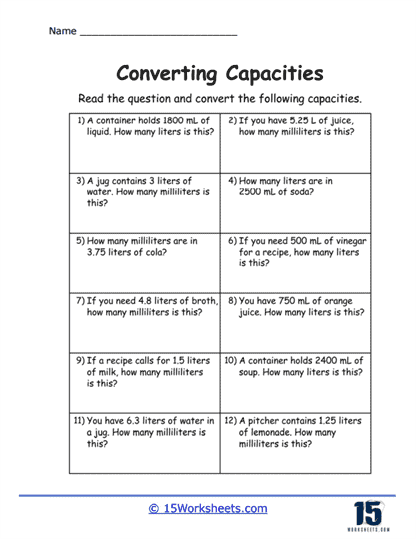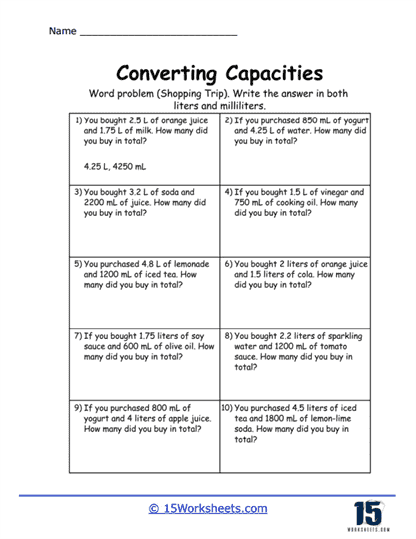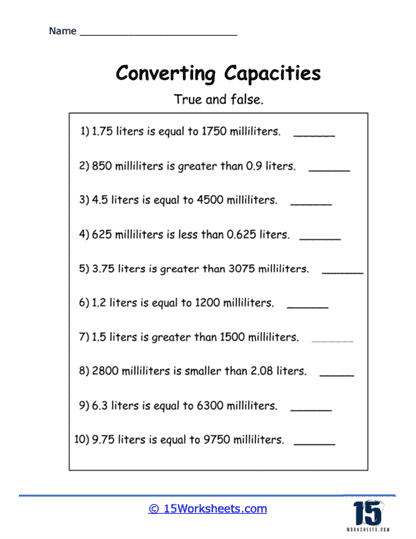Converting Metric Units of Capacity Worksheets
About These 15 Worksheets
This collection of worksheets will help students understand and practice the concepts of measuring and converting units of capacity. These worksheets are widely used in educational settings to strengthen students’ grasp of volume measurements in both standard and metric systems. Typically, these units include liters and milliliters in the metric system, and gallons, quarts, pints, and cups in the U.S. customary system. The primary goal of these worksheets is to enable students to become proficient in handling different volume units through a variety of practical and theoretical exercises.
By working through these worksheets, students enhance their mathematical abilities, become more detail-oriented, and learn practical skills that apply beyond the classroom into everyday life. These worksheets not only support academic growth but also foster critical thinking and real-world application skills.
1. Basic Conversion Exercises
These exercises form the core of Units of Capacity Worksheets. They require students to convert between different units of capacity within the same measurement system. For example, converting gallons to quarts or liters to milliliters. These problems teach students the specific conversion ratios, such as 1 gallon equals 4 quarts or 1 liter equals 1,000 milliliters. Students practice multiplying or dividing quantities by these conversion factors to complete the exercises, reinforcing their understanding of the size relationships between different units.
2. Word Problems
Word problems incorporate real-world scenarios that require the application of capacity units. These exercises might describe a situation where someone is baking and needs to convert recipe ingredients from cups to pints or a mechanic who needs to convert the oil needed for an engine from liters to milliliters. Word problems help students apply their mathematical skills to everyday situations, enhancing their problem-solving abilities and their understanding of when and how different units of capacity are used.
3. Matching Exercises
Matching exercises typically involve columns of equivalent capacities that students need to pair correctly. For instance, students might need to match a list of measurements in gallons with their equivalent in quarts. This type of exercise helps students quickly recognize relationships between units, fostering a more intuitive understanding of volume conversions.
4. Fill-in-the-Blank
Fill-in-the-blank exercises provide students with sentences or conversion tables where certain data points are missing. Students must calculate and fill in the correct values based on the context provided. These exercises are effective for assessing students’ understanding of unit conversions and their ability to compute the necessary changes accurately.
5. Multiple-Choice Questions
These questions present students with a problem and several possible answers. For example, a problem might ask how many pints are in three gallons, with multiple choice options provided. Multiple-choice format is useful for testing students’ knowledge and understanding quickly and can serve as a diagnostic tool to identify areas where students may need further instruction.
6. True or False Questions
True or false exercises ask students to evaluate statements about capacity measurements and conversions to determine their accuracy. This type of question challenges students to critically think about the properties of different units and the truthfulness of statements related to conversions and measurements.
7. Graphical Representation Questions
Some worksheets might include exercises that require students to draw or interpret graphs showing different quantities of liquids in various units. For instance, students could be asked to graph the relationship between the number of cups and pints or to interpret a graph showing changes in a reservoir’s water level in liters over time. These exercises help students visualize data and understand trends or patterns in data involving capacity.
8. Unit Estimation
Estimation exercises are crucial for helping students develop a sense of scale. Students might be asked to estimate the capacity of various containers in everyday life, such as estimating how many liters a swimming pool can hold or the number of pints in a water bottle. Estimation tasks enhance students’ practical understanding of volume and prepare them for real-life applications of measurement.
Practical exercises may require students to measure the capacity of objects or containers directly. This can involve using water and measuring cups or graduated cylinders to fill and then calculate the capacity of various items. This hands-on approach solidifies theoretical knowledge through direct application.
What Is Capacity?
Capacity refers to the amount of space inside a container or an object that can be filled with a fluid, grain, or other materials that can flow and take the shape of their container. It is a measure of volume, particularly in the context of how much liquid a container can hold. Understanding capacity is essential for numerous everyday activities, from cooking to fueling a car, and is critical in various scientific and industrial applications.
Units of Capacity
The units used to measure capacity vary significantly depending on the system of measurement (metric or imperial) and the application. Here’s an overview of the primary units:
Metric System
Liters (L) – The liter is the base unit of volume in the metric system, commonly used worldwide for everyday liquids such as beverages, gasoline, and water. One liter is the volume of a cube that measures 10 centimeters on each side.
Milliliters (mL) – A milliliter is one-thousandth of a liter, often used to measure smaller volumes. Common uses include measuring ingredients in cooking, medicine doses, and chemical solutions in laboratories.
Cubic Meters (m<sup>3</sup>) – Though not strictly a unit of capacity, cubic meters are also used to measure volume, especially for larger quantities like swimming pool volumes, freight containers, and room sizes.
U.S. Customary Units
Gallons (gal) – Used widely in the United States, the gallon is a standard unit for measuring larger volumes of fluids like milk, gasoline, and paint. The US gallon is defined as 231 cubic inches or approximately 3.785 liters.
Quarts (qt) – A quart is one-fourth of a gallon, used to measure both liquids and dry substances. Common applications include cooking measurements and engine oil volumes.
Pints (pt) – A pint is half a quart. It is often used in the U.S. for measuring beverages and sometimes smaller amounts of produce.
Cups – A cup is a common volume measure in cooking, equal to half a pint. Recipes frequently use cups for both liquid and dry ingredients.
Fluid Ounces (fl oz) – This unit is used to measure smaller volumes of liquids, such as in cooking or serving sizes of beverages.
Capacity Measurements in the Real World
Cooking and Baking
Units of capacity such as cups, tablespoons, liters, and milliliters are crucial in cooking and baking for measuring ingredients accurately. These measurements ensure that the balance of ingredients complies with the recipe, which is essential for achieving the intended taste, texture, and consistency of dishes. Precise capacity measurements also allow for the successful scaling of recipes up or down to cater to different serving sizes.
Medicine
In medicine, units of capacity like milliliters and liters are used to measure and administer liquid medications, ensuring patients receive the correct dosage. Capacity measurements are also critical in preparing solutions for intravenous infusion, where exact concentrations of drugs must be maintained. Additionally, capacity units help manage fluid intake and output for patients, which is vital for treatments involving fluid balance, such as in dialysis.
Chemistry and Biology
Units of capacity are fundamental in chemistry and biology for measuring and mixing chemicals and biological samples with precision. These measurements are essential for conducting experiments where the volume of reagents affects the chemical reaction rates and the outcomes of biological assays. Accurate capacity measurements also support standardization and replication of experiments, which are critical for scientific research.
Agriculture
In agriculture, capacity measurements are used to distribute water through irrigation systems efficiently, ensuring that crops receive adequate water without wastage. Farmers also use units of capacity to measure and apply pesticides and fertilizers properly, optimizing growth while minimizing environmental impact. Additionally, understanding the capacity of storage facilities for grains and other produce is crucial for maintaining quality and determining market readiness.
Fuel and Energy
Units of capacity such as gallons and liters are integral in the fuel and energy sectors to measure and sell petroleum products. Accurate measurement of fuel capacity ensures compliance with trading standards and helps in managing the supply chain of energy products. Capacity measurements are also crucial for assessing the storage capabilities of fuel tanks and the volume of biofuels produced from renewable sources.
Manufacturing and Industry
Industries rely on capacity measurements for processes involving liquids, such as beverages, chemicals, and other fluid products, ensuring precision in production and packaging. In manufacturing and industry, capacity measurements guide the proportions of raw materials mixed in production processes, ensuring product quality and consistency. These measurements are vital for managing the volumes of liquids in large-scale industrial processes, such as in the production of beverages, chemicals, and pharmaceuticals. Furthermore, capacity units are used to determine the filling levels in packaging, crucial for meeting legal standards and consumer expectations.
Environmental Science
Water capacity measurements in liters or cubic meters are vital for managing reservoirs, studying rainfall patterns, and planning irrigation systems. Environmental scientists use units of capacity to measure water bodies for resource management, pollution control, and ecological assessments. Measuring rainfall and river flow in capacity units helps in flood risk assessment and water resource planning. Additionally, capacity measurements are vital in calculating the volume of pollutants in water and air, aiding in the enforcement of environmental regulations and the preservation of public health.
Understanding and accurately measuring capacity is fundamental across all these areas, enabling precise control over recipes, dosages, chemical reactions, and economic transactions involving liquids. This ability significantly impacts daily life, technology, economy, and environmental management, making it a critical component of education and professional training in various fields.


